The CoPulsation™ Milking System is the only humane way to milk a cow with a machine. CoPulsation™ provides a unique gentle massage action on the full length of the teat. This massage action is very similar to the action provided by a calf. This liner action enables to blood flow to be properly re-established during the rest phase relieving the teat of the affects of the milking vacuum. This liner action also eliminates the back-washing of the teat with milk preventing cross-contamination of contagious bacteria such as Staph aureus.
Conventional milking machines cause the liner to simply pinch at the end of the teat and fail to relieve the milking vacuum. The result is a painful milking experience that results in teat swelling and physical tearing of the teat canal soft tissue lining resulting in scar tissue formation and slow milking quarters. The pinching action also causes a harmful reverse milking action. This reverse milking action is effectively the opposite of hand milking and forces the bacteria in the teat canal up the canal and into the teat sinus causing mastitis infections.
Anyone can readily feel the difference in liner actions provided by CoPulsation™ Milking System when compared to a conventional system. Placing ones fingers into the working machines/liners allows one to physically feel the painful sucking action of a conventional system and contrast that with the pleasant and gentle massage action of CoPulsation™. We routinely demonstrate this at trade shows and visitors quickly discover they can only tolerate the conventional system for a short time while they can leave their fingers in CoPulsation™ for an extended duration without discomfort.
The cows can readily tell the difference. Studies (JDS 85:2551-2561) have proven that the average cow will kick at the conventional milking machine an average of .4 times per minute. Cows milked with the CoPulsation™ Milking System do not exhibit this kicking characteristic. In milking parlors where one side is conventional and one is the CoPulsation™ Milking System, cows will learn in a couple of milking which side is more gentle and will prefer to enter the CoPulsation™ Milking System side.
Farmers have noted that the cows are much calmer with the CoPulsation™ Milking System. The photos below show a group of cows in a large parlor being milked. Note that there are no hose supports required to aid in keeping the machines on the cows. Also note that the teat shown has no milk on it and was taken immediately after the machine was removed.
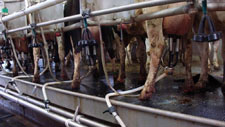
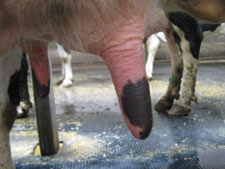
One farmer commented “the milkers had the biggest smiles on their faces because the cows were so much more content in the parlor. This is the best thing in dairying that I have come across , I will not dairy again without it!” after using the system for a week on his 1400 cow dairy.
Examples of cows milked with the CoPulsation™Milking System
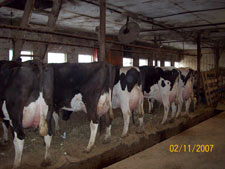
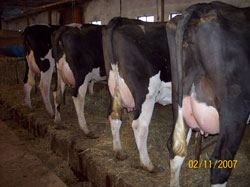
The above photos are from a herd of cows milked with CoPulsation™ for many years. The entire herd had similar healthy well-shaped udders.
There is no doubt that conventional milking machines are simply a painful way to milk cows. The pinching action is something that anyone can readily feel. Few, if any individuals, can tolerate having their finger in the machine for the duration of time it takes to milk a cow. The cows routinely kick at the machines and rapidly leave the parlor when done. Many studies have documented the fact that cows milked with conventional machines consistently have swollen teats after the machine is removed. The constant physical stress leads to internal damage to the canals which is also a documented fact in published studies. This leads to the loss of milking function in those quarters as mastitis becomes a problem. The photos below are evidence of the typical physical damage. Even the University of Washington documented (JDS 84:1976-1978) the fact that they had to chemically blind teats to deal with their problems. Various other approaches are taken to blind teats including banding (shown below) and physically removing the problem teat.
Examples of pain and damage caused by conventional milking systems
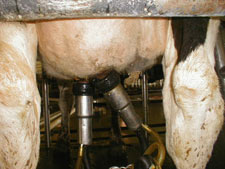
Blinded teat
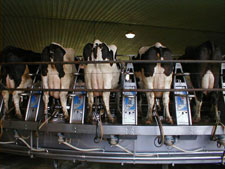
Damaged/uneven udders